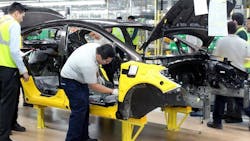Kia Mexico Moves Forward Despite Hardball Stance by Trump-Like 'El Bronco'
Some call him the Donald Trump of Mexico, and the locals in the northern state of Nuevo Leon have labelled him El Bronco, literally meaning a rough, tough, harsh individual.
But Jaime Rodríguez Calderón, Nuevo Leon’s governor, has managed to chop incentives provided for Kia’s new assembly plant and its affiliated suppliers from about 28% of the total $3 billion investment package to 10.5%, according to reports in Mexico.
Kia refuses to discuss the details, but government officials in Nuevo Leon say the automaker agreed to increase purchases from local Mexican suppliers, accept a reduction in the previous 20-year tax exemption to a 95% exemption for five years and let the state off the hook for paying for electricity and water.
The officials note Nuevo Leon’s training costs are substantial and cover 1,600 workers at the assembly plant and 5,500 at the 15 Korean supplier companies that set up operations to service Kia. Of the total workforce of 7,100, all but 200 of them reportedly are Mexican nationals.
A Kia spokesman does not disclose how many employees now are working in the newly opened plant, but says the number will rise to 3,000 when the facility reaches full capacity in 2017. Including supplier operations, the project will provide employment for 14,000 workers, he notes.
The Kia plant in Pesqueria, Nuevo Leon, came on stream with an initial annual production capacity of 100,000 vehicles, with line speed set at 59 units per hour. The plan is to rapidly expand capacity to 300,000 vehicles annually. About 80% of production is earmarked for export markets, including the U.S.
The first vehicle in production is the C-segment Kia Forte, called the Cerato in some export markets and the K3 in Korea. It will be followed by the Kia Rio in January and the Hyundai Accent in June 2017, according to WardsAuto data.
El Bronco risked putting up a virtual wall in his state that might keep future investors out, some critics say. As soon as he took office in October last year, he tore up the incentives contract with Kia and halted all work on the promised infrastructure the plant badly needed – sewer lines, water delivery conduits, rail spurs to connect the plant with the nearby rail line and paving of the substandard dirt road that runs past the plant.
He demanded renegotiation of the deal and has twisted Kia’s arm mercilessly ever since.
At present, it is necessary to move completed vehicles entirely by truck over Mexico’s rugged road system, because there are no spurs connecting the plant with the rail network.
The whole investment package totals more than $3 billion, including investments by Hyundai Motor Group affiliates and other suppliers in Nuevo Leon to support the Kia operation.
“Fifteen Tier 1 Korean suppliers entered into Mexico with Kia,” a Kia spokesman says.
The area has such a concentration of Korean investment money the locals have colloquially renamed the small city where the plant and most suppliers are located “Peskorea.”
Among Hyundai Group affiliates, Hyundai Mobis has constructed a $418 billion plant in Nuevo Leon that will supply unspecified modules and headlamps. Hyundai Wia invested $371 million to build an engine plant adjacent to the Kia assembly plant, and Hyundai Steel put $44 million into a facility in Monterey, Nuevo Leon, to supply cold rolled steel plates.
Among non-affiliates is Kodaco-Mexico, which constructed a $100 million plant in the neighboring state of Coahuila to supply air conditioners and brake components. Korea's Posco Steel also made investments for new facilities to serve the plant.
Political Intervention
It took intervention by Korea President Park Geun-hye to get Rodríguez Calderón to take a more conciliatory stance with Kia. She put the matter before Mexican President Enrique Pena Nieto during her state visit in April to discuss a possible free-trade agreement between the two nations.
Although Kia and its affiliates have given up hundreds of millions in incentives, the automaker can look forward to a brighter future with the planned infrastructure improvements now back in place.
But the situation had been very serious. Before Mexico’s president leaned on Rodríguez Calderón, Kia reportedly had been threatening to take the matter to the International Center for Settlement of Investment Disputes at the World Bank in Washington for mediation. Some reports suggested the automaker could pull out of Mexico and set up a second plant in the U.S. instead.
Read More